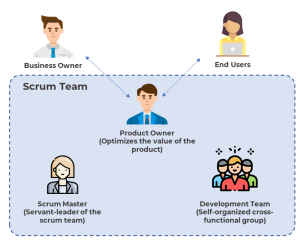
The Scrum method has managed to impact industries around the world. Even though it started in the software development domain to increase the final product’s efficiency and quality, its far-reaching benefits have resulted in Scrum being implemented across various companies spanning different industries. This article briefly introduces what Scrum is and Scrum methodology pros and cons.
Introduction to Scrum
The Scrum Framework is a part of the overall Agile methodology developed to increase any organization’s output in the most efficient way possible. It is focusing on utilizing all available resources efficiently to drive optimal results. The Agile methodology has been widely accepted worldwide, and the Scrum method is one of the most popular methods in use.
A recent study showed that out of all the respondents who were using Agile in their organization, 56% utilized Scrum. The reason given for this was that Scrum helped teams within the company simplify complicated tasks and break them down to improve their overall workflow.
So what exactly is the Scrum Framework?
The Scrum framework is one of the main Agile methodology frameworks used in projects by the teams to deliver a finished product in a sprint of two or four weeks. After each sprint gets over, the product gets reviewed, feedback is produced, and the next sprint begins. The iterative approach to project completion helps improve the product with each iteration and helps deliver maximum value to the end-user.
Scrum has gained immense popularity in the software development sector. The most recent report, known as the 14th State of Agile Report, noted that over 70% of software companies were using Scrum as their primary means of operation, or a Scrum hybrid with different frameworks. Scrum is also an efficient way of managing long-term and continuous projects because it divides time and focuses on completing small goals to align them with the project’s main goal over a certain period of time. Now let us explore scrum methodology pros and cons in detail.
Advantages of Scrum Methodology
There are two big pros of implementing Scrum method in any organization. The first one is that Scrum teams complete their projects of a much higher quality. The second biggest advantage of using Scrum is that it ensures that Scrum teams operate in the most efficient manner possible.
Scrum utilizes time and financial resources efficiently because Scrum teams plan preemptively and budget their finances before they begin any project. This helps in eliminating any unforeseen expenses and lapses in time. Towards the end of each sprint, Scrum teams also test out their product before release so that they can find any possible flaws that may have occurred and fixed them.
A new project has many variables and elements that need to be accounted for to ensure its success upon completion. Scrum methods make keeping track of these elements much easier because they break down big tasks into smaller, more workable parts and teams have a much more relatable approach to completing them.
Projects may change and develop over time, which means the project requirements may also change with them. Scrum is an approach that accommodates changes effortlessly because the Scrum teams work in sprints, and any changes that need to be made can be implemented easily in the next sprint. They do not have to start from the very beginning, which is what often happens with teams that follow the Waterfall methodology.
Another aspect of Scrum is their daily Scrum meetings that the Scrum team engages in. This helps the entire team keep track of each iteration’s progress and find any hiccups they may face early on into the project. This also showcases the tasks each team member has completed daily, so there is more validation for their hard work.
Disadvantages of Scrum Methodology
While all the points mentioned above make the Scrum method sound like the perfect solution for all project-based issues, there are certain drawbacks to this method as well. Since Scrum projects do not have a definite timeline and work based on each sprint, projects can get drawn out for longer than they are supposed to. There is no specific final iteration because Scrum is focused on continuous improvement. This can prove to be a disadvantage.
Scrum teams sometimes have difficulty adopting the Scrum methodology because it is a big change from their traditional working methods. The Scrum teams work fairly independently, and the Scrum Master and project manager do not always have to oversee and micromanage their tasks, which can prove to be a hindrance. Scrum team members can also face difficulty adopting a completely different approach to working, and this can cause delays. Especially when teams are not trained and educated enough in Agile and Scrum methods, the lack of experience and expertise can cause issues.
Sometimes, teams do not test as aggressively as they need to with each iteration, so it can negatively impact the final product’s quality. Scrum teams need to be fully committed to their project and each part of the Scrum process for it to work effectively.
Another con of using Scrum methods is that it works best if the team is small. A typical Scrum team comprises four to six team members. Communication is key in Scrum, and this can be a problem in large teams. Every step needs to be thoroughly documented and addressed, which can be an issue if the team size is too large, and it can also lead to frustration among team members.
More often than not, Scrum teams face problems only because the Scrum processes have not been implemented correctly and the teams have not been trained properly. Once this hurdle is out of the way and communication is streamlined, Scrum processes can help all projects in any organization.
Final Thoughts
The best and most efficient way to adopt Scrum methods in any organization is to train all teams and project managers in the Agile methodology and scrum processes. With knowledge and expertise in Scrum, teams can effectively incorporate the methodology in their day-to-day work processes and achieve optimal results and deliver their projects.
At Invensis Learning, we provide various Agile certification courses that will help you to master multiple Agile frameworks, including Scrum. Enroll now and take the next step in your pursuit to master Agile. I hope you found this article on Scrum Methodology’s pros and cons interesting. Do let us know in the comment section below.
















